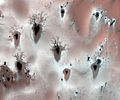Fayl:Fractal defrosting patterns on Mars.jpg
Qiyofa

Bu prevyuning hajmi: 719 × 600 piksel. Boshqa oʻlchamlari: 288 × 240 piksel | 575 × 480 piksel | 921 × 768 piksel | 1 227 × 1 024 piksel | 2 455 × 2 048 piksel | 3 157 × 2 634 piksel.
Asl fayl (3 157 × 2 634 piksel, fayl hajmi: 7,99 MB, MIME tipi: image/jpeg)
Fayl tarixi
Faylning biror paytdagi holatini koʻrish uchun tegishli sana/vaqtga bosingiz.
| Sana/Vaqt | Miniatura | Oʻlchamlari | Foydalanuvchi | Izoh | |
|---|---|---|---|---|---|
| joriy | 19:01, 2014-yil 28-yanvar |  | 3 157 × 2 634 (7,99 MB) | Tillman | {{Information |Description ={{en|1=This image is from the high latitudes in the Southern hemisphere, about half-way through southern spring. Just like on the Earth, the frost layer that accumulates over the winter will disappear as summer approache... |
Fayllarga ishoratlar
Bu faylga quyidagi 2 sahifalar bogʻlangan:
Faylning global foydalanilishi
Ushbu fayl quyidagi vikilarda ishlatilyapti:
- be.wikipedia.org loyihasida foydalanilishi
- en.wikipedia.org loyihasida foydalanilishi
- he.wikipedia.org loyihasida foydalanilishi
- sq.wikipedia.org loyihasida foydalanilishi
- th.wikipedia.org loyihasida foydalanilishi
- uk.wikipedia.org loyihasida foydalanilishi


